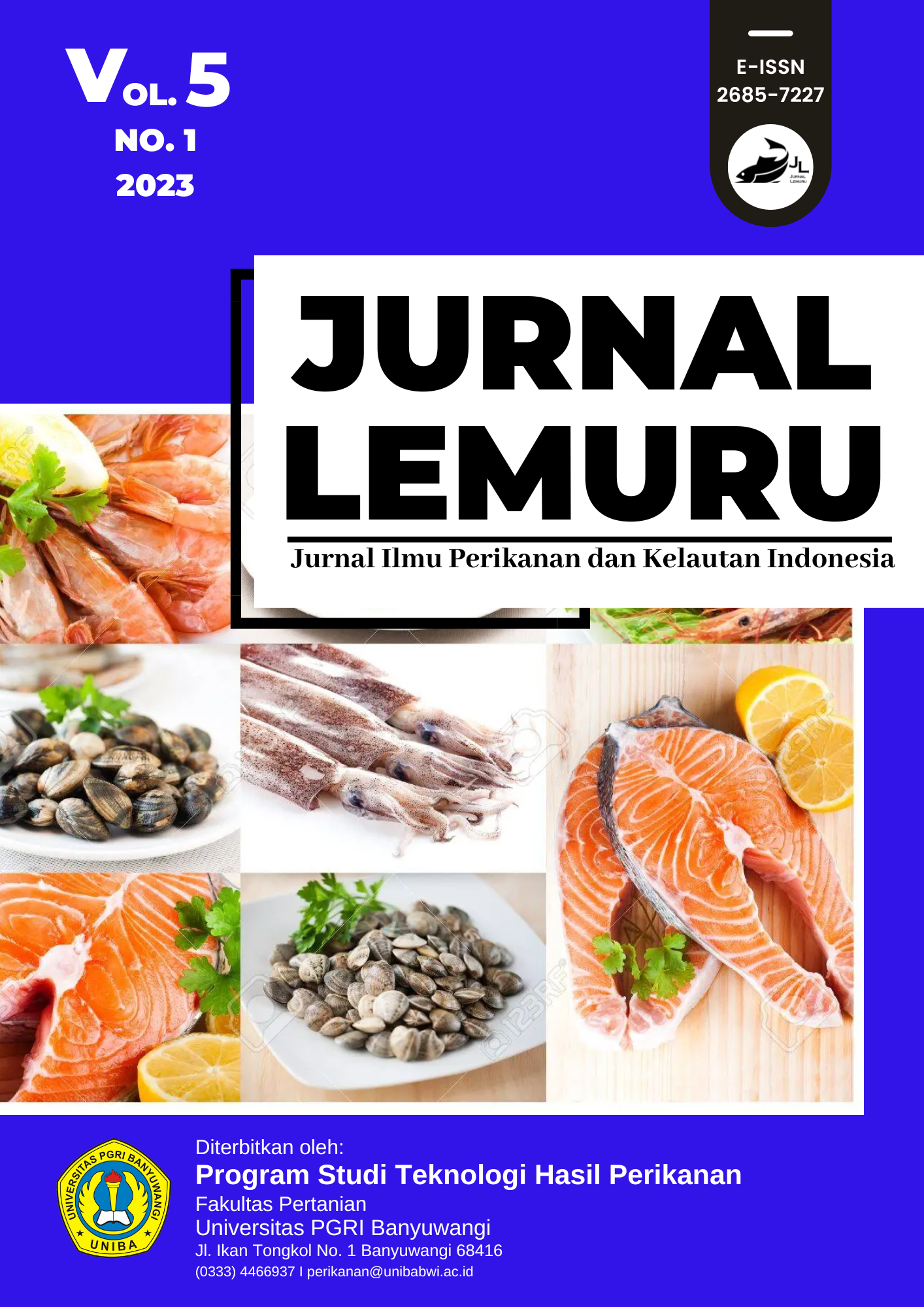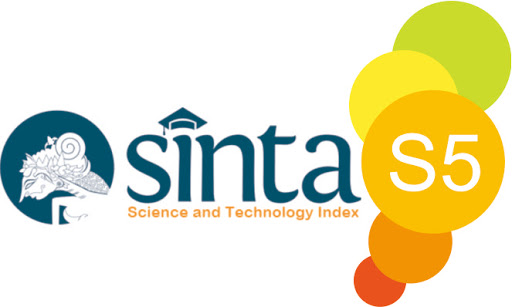PISANG RAJA OVERRIPE SEBAGAI SUMBER KARBON PADA PERTUMBUHAN MIKROALGA Thraustochytrids PENGHASIL DHA
DOI:
https://doi.org/10.36526/jl.v5i1.2393Keywords:
Mikroalga, Thraustochytrids, Mangrove, Sari Pisang, DHAAbstract
Indonesia merupakan negara yang memiliki potensi signifikan dalam produksi mikroalga, namun pemanfaatannya masih sangat terbatas. Terdapat banyak penelitian terbarukan yang menyatakan bahwa banyak jenis mikroalga yang mampu menghasilkan metabolit berupa asam lemak omega-3 DHA dan EPA dengan konsentrasi tinggi, yang juga dapat menurunkan biaya produksinya. Thraustochytrids merupakan mikroalga penghasil lipid yang tumbuh di habitat laut dan bakau. Dalam pertumbuhannya, Thraustochytrids bersifat heterotrof dimana sumber karbon yang digunakan adalah glukosa. Pisang raja dapat menjadi sumber karbon yang menjanjikan bagi pertumbuhan Thraustochytrids terkait dengan kandungan glukosanya yang mencapai 18,55% ketika dalam keadaan overripe (limbah). Pada penelitian ini dilakukan studi terkait produksi biomassa kering mikroalga Thraustochytrids yang diisolasi dari daun mangrove (Rhizophora apiculata). Pada lama waktu fermentasi yaitu 5 dan 7 hari, dan konsentrasi sari pisang raja overripe pada 0%, 25%, 50%, 75%, dan 100% diperoleh berat biomassa kering yang berbeda. Berat kering 3,9 g/L pada konsentrasi sari pisang 50% di hari ke-7 fermentasi serupa dengan glukosa murni (0% sari pisang) yaitu sebesar 3,95 g/L di hari yang sama. Biomassa kering yang dihasilkan ke depannya dapat diekstrak lebih lanjut untuk menghasilkan asam lemak tak jenuh seperti DHA dan EPA.
References
Anggraena, F. W. (2018). Validasi Metode Analisa Penetapan Kadar Nystatin Dalam Tablet Nystatin Salut Gula 500.000 IU Secara Hplc (High Performance Liquid Chromatography). [Skripsi]. Yogyakarta: Universitas Islam Indonesia.
Bengen, D. G. (2001). Sinopsis Ekosistem dan Sumber Daya Alam Pesisir. Institut Pertanian Bogor: Pusat kajian Sumber Daya Pesisir dan Lautan.
Chen F, Johns M. R . (1995). A Strategy for High Cell Density Culture of Heterotrophic Microalgae with Inhibitory Substrates. J Appl Phycol 7:43–46
Crawford, M. A., Leigh Broadhurst, C., Guest, M., Nagar, A., Wang, Y., Ghebremeskel, K., & Schmidt, W. F. (2013). A quantum theory for the irreplaceable role of docosahexaenoic acid in neural cell signalling throughout evolution. Prostaglandins, Leukotrienes and Essential Fatty Acids (PLEFA), 88(1), 5–13. doi:10.1016/j.plefa.2012.08.005 10.1016/j.plefa.2012.08.005
Fathurohman, M. (2017). Optimasi Produksi Asam Lemak Docosahexaenoic Acid (DHA) dari Mikroalga dengan Variasi Sumber Nitrogen. Jurnal Kesehatan Bakti Tunas Husada Vol. 17 No.2
Julianti, E., Fathurohman, M., Damayanti, S. & Kartasusmita, R. E. (2018). Isolate of Heterothrophic Microalgae Thraustochytrium aureum as a Potential Source of Docosahexanoic Acid (DHA). Mar. Res. Indonesia Vol. 43, No. 2, 2018: 79-86
Liang, Y., Sarkany, N., Cui, Y., Yesuf, J., Trushenski, J., & Blackburn, J. W. (2010). Use of sweet sorghum juice for lipid production by Schizochytrium limacinum SR21. Bioresource Technology, 101(10), 3623–3627. doi:10.1016/j.biortech.2009.12.087
Li X. F., Xu H., Wu Q. Y .2007. Large-scale Biodiesel Production from Microalga Chlorella protothecoides Through Heterotrophic Cultivation in Bioreactors. Biotechnol Bioeng 98:764–771
Marriott, J., Robinson, M. & Karikari, S.K. (1981). Starch and Sugar Transformation during the Ripening of Plantains and Bananas. Journal of the Science of Food and Agriculture, 32 (10), 1021-1026, 1981
Metzger, P., & Largeau, C. (2004). Botryococcus braunii: a rich source for hydrocarbons and related ether lipids. Applied Microbiology and Biotechnology, 66(5), 486–496. doi:10.1007/s00253-004-1779-z
Molina, E. C. et al. (2017). Isolation and Molecular Characterization of Thraustochytrium Strain Isolated from Antarctic Peninsula and its Biotechnological Potential in the Production of Fatty Acids. Brazilian Journal of Microbiology http://dx.doi.org/10.1016/j.bjm.2017.01.011
Paul, P.C. & H. P. Halen. (1981). Fruit Theory and Application, John Willey and Sons Inc. Co., New York.
Pleissner, D., Lam, W. C., Sun, Z., & Lin, C. S. K. (2013). Food Waste as Nutrient Source in Heterotrophic Microalgae Cultivation. Bioresource Technology, 137, 139–146. doi:10.1016/j.biortech.2013.03.088
Raghukumar, S. (2002). Ecology of the marine protists, the Labyrinthulomycetes (Thraustochytrids and Labyrinthulids). European Journal of Protistology, 38(2), 127–145. doi:10.1078/0932-4739-00832
Ryckebosch, E., Bruneel, C., Muylaert, K., & Foubert, I. (2012). Microalgae as an Alternative Source of Omega-3 Long Chain Polyunsaturated Fatty Acids. Lipid Technology, 24(6), 128–130. doi:10.1002/lite.201200197
Sayanova, O., Ruiz-Lopez, N., Haslam, R. P., & Napier, J. A. (2011). The role of Δ6-desaturase acyl-carrier specificity in the efficient synthesis of long-chain polyunsaturated fatty acids in transgenic plants. Plant Biotechnology Journal, 10(2), 195–206. doi:10.1111/j.1467-7652.2011.00653
Sijtsma, L. (2004). Marine micro-‐organisms as new sources of n-‐3 polyunstaurated fatty acids (PUFA). In: Functional foods, cardiovascular disease and diabetes. Edited by: A. Arnoldi. 2004. CRC Press. Boca Raton.
Sun, G. Y., Simonyi, A., Fritsche, K. L., Chuang, D. Y., Hannink, M., Gu, Z., … Beversdorf, D. Q. (2017). Docosahexaenoic acid (DHA): An essential nutrient and a nutraceutical for brain health and diseases. Prostaglandins, Leukotrienes and Essential Fatty Acids (PLEFA). doi:10.1016/j.plefa.2017.03.006
Sylvia, N., Meriatna & Haslina. (2015). Kinetika Hidrolisa Kulit Pisang Kepok Menjadi Glukosa Menggunakan Katalis Asam Klorida. Jurnal Teknologi Kimia Unimal 4 : 2 (November 2015) 51-65
Winarno, F.G. (2010). Enzim Pangan. Bogor: M-Brio Press.
Downloads
Published
How to Cite
Issue
Section
License
Copyright (c) 2024
This work is licensed under a Creative Commons Attribution-ShareAlike 4.0 International License.











